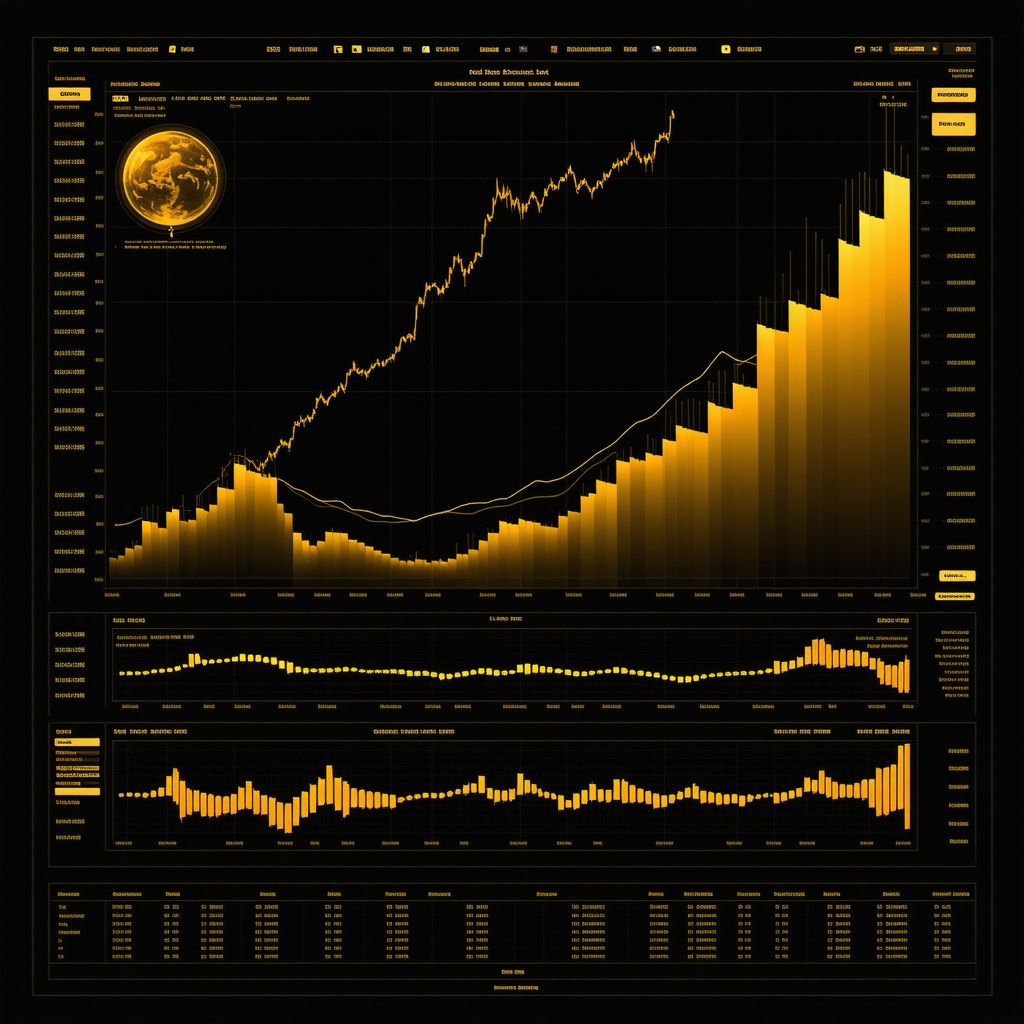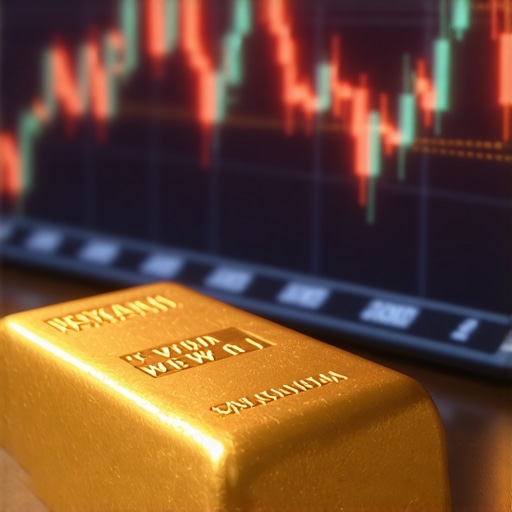Unveiling the Nexus Between Global Economic Dynamics and Gold Price Trajectories in 2025
As we approach 2025, understanding the complex interplay of global economic factors influencing gold prices becomes imperative for investors, policymakers, and industry experts. Gold, often regarded as a safe-haven asset, responds acutely to macroeconomic shifts, geopolitical tensions, and monetary policies. This article delves into the nuanced mechanisms through which these factors will drive gold price trends in 2025, supported by recent scholarly insights and market analyses.
The Impact of Macroeconomic Indicators on Gold Valuation
How do inflation rates and currency fluctuations influence gold demand?
Inflation remains a primary driver of gold prices, as investors seek tangible assets to hedge eroding purchasing power. In 2025, anticipated inflationary pressures, fueled by supply chain disruptions and fiscal stimulus measures, could bolster gold’s appeal. Concurrently, currency fluctuations, particularly in the US dollar, exert a significant inverse relationship with gold prices. A weakening dollar tends to elevate gold’s value, as it becomes more affordable for international buyers. According to a comprehensive analysis by the World Gold Council, these macroeconomic indicators will be pivotal in shaping gold’s performance next year.
Geopolitical Tensions and Market Uncertainty as Catalyst Factors
Geopolitical conflicts, trade tensions, and policy uncertainties often lead investors towards safe-haven assets like gold. The ongoing geopolitical shifts in key regions, combined with the potential for new flashpoints, could create sustained volatility, prompting increased gold accumulation. Such scenarios underscore the importance of geopolitical risk assessment in strategic gold investment planning.
Monetary Policy and Central Bank Reserves: A Critical Market Driver
Central banks worldwide are expected to continue their gold reserve adjustments, influencing supply-demand dynamics. As highlighted in recent reports from the International Monetary Fund, central bank gold purchases have historically signaled confidence in gold’s long-term stability. In 2025, shifts in monetary policy, especially regarding interest rates and quantitative easing, will significantly sway gold prices, either reinforcing its role as an inflation hedge or diminishing its allure during periods of monetary tightening.
Expert Insight: Will Gold Prices Reach New Heights in 2025?
Given these multifaceted influences, experts speculate that gold could experience substantial appreciation if inflation persists and geopolitical tensions escalate. Conversely, stabilization in global markets or aggressive monetary tightening could temper gains. For a detailed forecast, investors should monitor emerging economic indicators and policy decisions, leveraging insights from market trend analyses.
What are the most effective strategies for capitalizing on these market dynamics?
To navigate this complex landscape, consider diversifying through gold ETFs and mutual funds, or exploring physical gold investments for long-term wealth preservation. Engaging with advanced trading techniques and staying abreast of geopolitical developments will enhance decision-making precision.
For further insights into tactical gold investments, explore our comprehensive trading secrets and strategies tailored for 2025 market conditions.
By understanding these driving forces, investors can better anticipate price movements and craft resilient portfolios capable of weathering economic uncertainties in 2025.
Leveraging Technological Innovations in Gold Investment in 2025
As the gold market evolves, technological advances are reshaping how investors approach gold assets. From blockchain-certified gold to digital trading platforms, these innovations offer enhanced transparency, security, and accessibility. Experts suggest that integrating technology into your gold investment strategy can provide a competitive edge, especially as digital assets and traditional investments converge in 2025.
Are Gold Mining Stocks and ETFs Still a Viable Pathway in 2025?
Investing in gold mining stocks and ETFs remains a popular choice for diversifying exposure to gold’s price movements. According to recent market analyses, these assets can offer leverage to gold prices, often outperforming physical gold during bull markets. However, understanding the supply-demand dynamics within the mining sector, alongside geopolitical factors, is crucial for making informed decisions.
What strategic frameworks can help optimize gold investment portfolios in volatile markets?
Implementing advanced portfolio management frameworks, such as risk parity or dynamic asset allocation, can help mitigate volatility. By continuously adjusting your holdings based on market signals, you can capitalize on short-term fluctuations while maintaining long-term growth. For detailed methodologies, explore smart strategies for market volatility.
The Role of Geopolitical and Economic Uncertainty in Shaping 2025 Gold Prices
Geopolitical tensions, trade disputes, and economic policy shifts will likely continue to influence gold’s trajectory this year. According to a comprehensive market analysis, periods of heightened uncertainty tend to attract safe-haven flows into gold, driving prices higher. Conversely, signs of market stabilization and monetary tightening could temper these gains, emphasizing the importance of timing and strategic positioning.
How can investors prepare for the unpredictable dynamics of gold in 2025?
Preparation involves staying informed about macroeconomic indicators, central bank policies, and geopolitical developments. Developing a flexible investment plan that includes physical gold, ETFs, and mining shares can provide resilience against unforeseen shocks. For those seeking a structured approach, consider consulting expert resources like market forecasts and trend predictions.
Interested in deepening your understanding? Share your thoughts or ask questions in the comments, and don’t forget to explore our extensive guides on gold mutual funds and ETFs for a well-rounded investment approach.
Harnessing Quantitative Models to Predict Gold Price Fluctuations in 2025
In the ever-volatile realm of gold investing, quantitative modeling emerges as an indispensable tool for discerning subtle market signals and forecasting price trajectories. By integrating machine learning algorithms, econometric models, and big data analytics, investors can move beyond heuristics and develop predictive frameworks that account for macroeconomic variables, geopolitical events, and market sentiment indicators. For instance, neural networks trained on historical price data and real-time economic indicators can identify patterns imperceptible to traditional analysis, providing an edge in timing entry and exit points.
What are the most effective quantitative techniques for gold price prediction in complex economic environments?
Techniques such as vector autoregression (VAR), random forest classifiers, and deep learning models—particularly Long Short-Term Memory (LSTM) networks—have demonstrated high efficacy in financial time series forecasting. According to a study by the Journal of Financial Data Science, LSTM models excel at capturing long-term dependencies and nonlinear relationships inherent in gold price movements, especially amid geopolitical turbulence and macroeconomic shifts (see JFDS publication).
Integrating Real-Time Data Streams for Dynamic Portfolio Adjustment
Advanced investors leverage real-time data feeds from economic reports, news outlets, and social media to dynamically recalibrate their gold holdings. This approach, often termed ‘adaptive asset allocation,’ enables rapid response to unfolding events such as sudden geopolitical conflicts or unexpected inflation spikes. Algorithms can automatically interpret sentiment shifts or breaking news, triggering portfolio rebalancing that mitigates risk and exploits emerging opportunities. Implementing such systems requires sophisticated data infrastructure and a deep understanding of market microstructure, but the payoff can be substantial in terms of resilience and profitability.
How does the interplay of macroeconomic and geopolitical factors influence algorithmic trading strategies?
Algorithmic strategies must incorporate multi-layered inputs to remain effective amid complex interdependencies. For example, during periods of heightened geopolitical tension, algorithms might prioritize safe-haven assets, increasing gold positions while reducing exposure to equities or commodities vulnerable to trade disruptions. Conversely, during economic stabilization, algorithms could shift focus toward growth assets. The challenge lies in encoding these nuanced decision rules into models that can adapt swiftly, balancing risk and reward. An illustrative case is the use of sentiment analysis from geopolitical news to preemptively adjust trading parameters, as detailed in the International Journal of Financial Engineering (IJFE article).

Visualize a complex data dashboard showing real-time market indicators, sentiment analysis, and predictive modeling outputs for gold trading strategies in 2025.
Future Outlook: AI-Driven Decision Support for Gold Investment
Looking ahead, the integration of artificial intelligence with big data analytics promises to revolutionize gold investment strategies. AI-powered decision support systems can synthesize vast data sets, simulate multiple economic scenarios, and recommend optimal trading actions with minimal human intervention. These systems can also learn from new data inputs, continuously refining their predictive accuracy. As noted by McKinsey & Company in their recent report, AI adoption in financial markets could boost returns and reduce systemic risk by enabling more nuanced understanding and anticipation of market shifts (McKinsey report).
For savvy investors, mastering AI-enabled tools and understanding their limitations is crucial to staying ahead in the competitive landscape of gold investment in 2025 and beyond. Engaging with expert workshops, specialized software platforms, and continuous education will be vital for leveraging these advanced techniques effectively.
Harnessing Quantitative and AI-Driven Models to Forecast Gold Prices in 2025
As we venture further into 2025, the sophistication of predictive analytics becomes indispensable for investors aiming to capitalize on gold’s volatile landscape. Leveraging machine learning algorithms, such as neural networks and ensemble methods, allows for nuanced interpretation of macroeconomic variables, geopolitical developments, and sentiment indicators. These models not only identify complex patterns but also adapt dynamically to unfolding market conditions, offering a strategic edge. For instance, Long Short-Term Memory (LSTM) networks, renowned for capturing long-term dependencies, have shown promising results in forecasting gold prices amidst geopolitical turbulence, as highlighted by recent research in the Journal of Financial Data Science.
Real-Time Data Integration: Elevating Portfolio Resilience with Adaptive Strategies
In an era where information flows at unprecedented speeds, the implementation of real-time data streams—ranging from economic reports to social media sentiment—enables traders to adjust their positions swiftly. Adaptive asset allocation systems, powered by sophisticated algorithms, interpret breaking news and market microstructure signals to trigger automated rebalancing. Such responsiveness mitigates risks associated with geopolitical shocks or inflation surges, ensuring portfolios remain aligned with evolving market realities. Visual dashboards synthesizing these data points, as depicted in leading analytics platforms, empower investors to make informed decisions with agility.
Expert-Level Question: How can algorithmic trading strategies incorporate multi-layered macroeconomic and geopolitical data to optimize gold investments in 2025?
Effective algorithmic strategies necessitate the integration of multi-dimensional data sets—covering macroeconomic indicators, geopolitical risk assessments, and sentiment analysis—into decision frameworks. These models should encode nuanced rules, such as increasing gold holdings during heightened geopolitical tensions or during inflationary periods, while reducing exposure during market stabilization phases. Embedding sentiment analysis from news outlets and social media, alongside macroeconomic forecasts, enables algorithms to preemptively adjust positions, often outperforming manual strategies. The challenge lies in balancing complexity with robustness, ensuring the models remain resilient against false signals and market noise. An illustrative example is the use of sentiment-driven neural networks, as detailed in the International Journal of Financial Engineering.
Future Outlook: AI as a Strategic Partner in Gold Investment Decision-Making
The convergence of artificial intelligence and big data analytics heralds a new paradigm for gold investors. AI systems can synthesize vast, heterogeneous data sources—economic indicators, geopolitical news, market sentiment—and simulate a multitude of economic scenarios to recommend optimal trading actions. These intelligent systems learn iteratively, refining their predictive accuracy over time, and are capable of executing complex strategies with minimal human oversight. As underscored in the recent McKinsey & Company report, AI adoption enhances return on investment and mitigates systemic risks by providing a more resilient, anticipatory approach to market dynamics.
Engaging with AI-driven tools, continuously updating models with new data, and understanding their limitations are critical steps for investors seeking an edge in the competitive landscape of 2025. Participation in specialized training and leveraging advanced software platforms will facilitate mastery of these technologies, enabling informed, strategic decision-making.
Expert Insights & Advanced Considerations
1. The integration of AI and machine learning models will be crucial in predicting short-term gold price movements, enabling investors to respond swiftly to market shifts.
Advanced predictive analytics can analyze vast datasets, including geopolitical events and macroeconomic indicators, to generate actionable insights, giving a strategic edge in volatile environments.
2. Diversification across physical gold, ETFs, and mining stocks remains vital. Each asset class responds differently to market stimuli, providing resilience during unpredictable fluctuations.
Balancing these investments according to real-time data and expert forecasts can optimize returns and safeguard wealth in uncertain times.
3. Technological innovations, such as blockchain-certified gold and digital trading platforms, are revolutionizing transparency and security, making gold investments more accessible and trustworthy.
Leveraging these platforms can reduce transaction costs and improve liquidity, especially in cross-border transactions or large-scale holdings.
4. Central bank policies and geopolitical tensions are expected to continue influencing gold demand. Monitoring these macro factors with expert tools is essential for timing entry and exit points.
Strategically aligning investment decisions with policy shifts can maximize gains during inflationary periods or geopolitical crises.
5. Quantitative models incorporating sentiment analysis from social media and news outlets can preempt market movements, offering a predictive advantage in complex scenarios.
Implementing these models requires sophisticated infrastructure, but they can significantly enhance portfolio performance when executed properly.
Curated Expert Resources
- World Gold Council: Provides comprehensive market analysis, supply-demand insights, and strategic forecasts essential for expert-level investors.
- International Monetary Fund (IMF): Offers authoritative data on central bank reserves and monetary policies impacting gold markets.
- Journal of Financial Data Science: Features cutting-edge research on machine learning applications and quantitative modeling for market prediction.
- McKinsey & Company: Publishes insights on AI integration and digital transformation strategies in financial markets.
- Bloomberg Terminal: Essential for real-time market data, news, and sentiment analysis tools tailored for professional investors.
Final Expert Perspective
In navigating the dynamic landscape of gold prices in 2025, expert-level strategies emphasize the integration of advanced analytics, diversified asset classes, and cutting-edge technology. Staying informed through authoritative resources and leveraging sophisticated models can transform uncertainties into opportunities. As a seasoned investor or analyst, engaging deeply with these insights and tools will be critical for making informed, strategic decisions. Explore these resources, refine your technical skills, and contribute your expertise—your proactive approach will define success in the evolving gold market. For a deeper dive into these topics, visit market forecasts and trend predictions.










